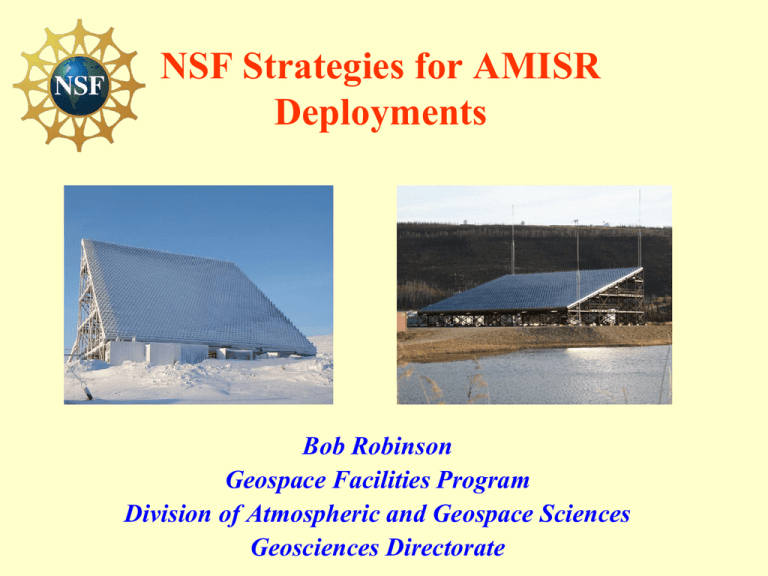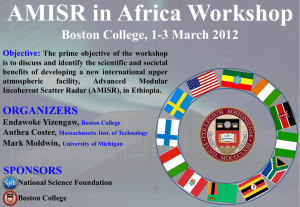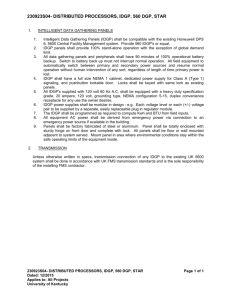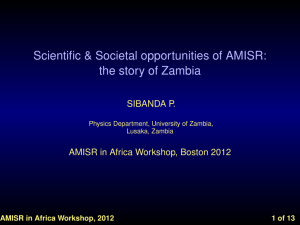NSF Strategies for AMISR Deployments
advertisement

NSF Strategies for AMISR Deployments Bob Robinson Geospace Facilities Program Division of Atmospheric and Geospace Sciences Geosciences Directorate NSF-supported ISRs--2012 The NSF Incoherent Scatter Radar Chain-2007 Chain-2006 AMISR- Resolute Bay (RISR) PFR 2007 PFISR 2007 RISR 2008 Sondrestrom (SRF) SRF SRF 1982 1982 AMISRPoker Flat MH MH 1962 1962 AMISR-Poker Flat (PFISR) Jicamarca (JRO) AO AO 1962 1962 Millstone Hill (MH) JRO JRO 1963 1963 Jicamarca (JRO) Arecibo (AO) AMISR Math 16-Panel Sub-Array Panel: 32 Antenna Element Units 128 Panels Full Array Possible AMISR Configurations AMISR-24 (128 panels) AMISR-14 (64 panels) AMISR-12 (32 panels) AMISR-23 (96 panels) AMISR-21 (32 panels) AMISR-22 (64 panels) AMISR-11 (16 panels) AMISR Status • Poker Flat AMISR (PFISR) began operation in January 2007 • One face of AMISR at Resolute Bay (RISR) began operating Fall 2008 • A second face at Resolute Bay has been constructed with funding from Canada Foundation for Innovation • 14 AMISR panels to be deployed in Argentina through MRI funding • 128 panels will be moved from Poker Flat to Argentina in 2013 • Proposal under review to build AMISR system in McMurdo; a possible option is to move 64 panels from Resolute Bay in exchange for Office of Polar Programs purchasing 64 new panels. Future NSF ISR Network The NSF Possible Incoherent Scatter Radar Chain-2006 Chain-2007 AMISRSub-auroral (1/2 face) RISR (1.5 faces) PFR 2007 Sondrestrom Sondrestrom (SRF) (SRF) SRF SRF 1982 1982 AMISRPoker Flat MH MH 1962 1962 AO AO 1962 1962 Jicamarca (JRO) Jicamarca (JRO) Argentina (AIRES) Millstone Hill Hill (MH) (MH) Millstone JRO JRO 1963 1963 McMurdo (MAISR) Arecibo (AO) Options for getting advice • NSF assembles a committee • NSF asks someone else to assemble a committee (e. g. National Academy) • NSF issues a solicitation • NSF organizes an open workshop Considerations in Developing AMISR Deployment Strategies • Science • Geophysical constraints (location, timing) • Ancillary instrumentation • Logistics (cost, power availability, frequency allocation, site support, etc.) • Partnerships • Politics • Global coverage • The versatility and flexibility of the AMISR design • Other opportunities (e. g. space missions) The Poker Flat Incoherent Scatter Radar (PFISR) Features: Proximity to Poker Flat Rocket Range Full array of optical instruments nearby Commercial power available (Able to operate at low duty cycle for prolonged measurements.) Technical support from U. of Alaska and Rocket Range Resolute Bay Incoherent Scatter Radar (RISR) Features: Highest latitude ISR Excellent partnership with Canada Many instruments already on site Technical support from local contractors Funding opportunities for AMISR development and deployment • MRI (Major Research Instrumentation) • DURIP (Defense University Research Instrumentation Program) • Mid-size Infrastructure funding opportunities (GEO, AGS, OPP) • MREFC (Major Research Equipment and Facility Construction) • International Partnering (Canada Foundation for Innovation, SuperDARN) Partnerships for Enhanced Engagement in Research (PEER) • U. S. Agency for International Development (USAID) will provide support for scientists in developing countries for: – – – – Laboratory improvement Equipment Education Research In collaboration with NSF-funded scientists at U. S institutions. PEER technical areas of interest include, but not limited to: • • • • Food security Global health Climate change Other topics: disaster mitigation, biodiversity, water, and renewable energy. Steps to Proposing New AMISR deployment locations • Identify a scientifically compelling location • Convene a workshop or other venue for soliciting broad community input • Prepare a document describing the scientific rationale for the location • Conduct a site survey to investigate logistical aspects, partnering opportunities, student participation, etc. • Work with NSF throughout, particularly with regard to funding strategies




